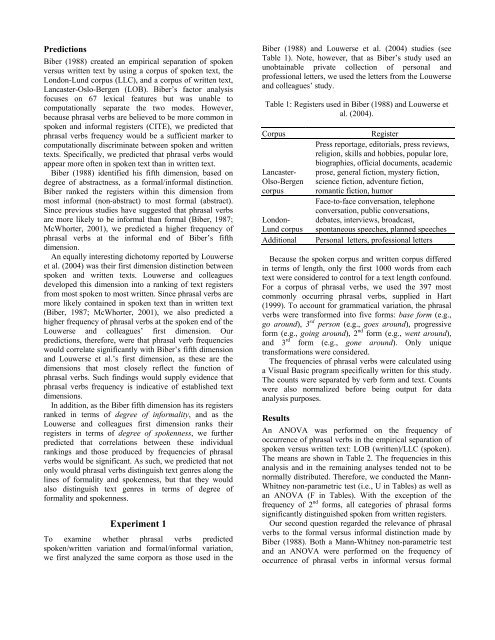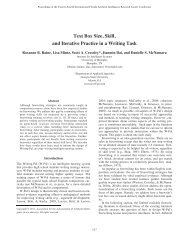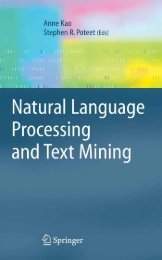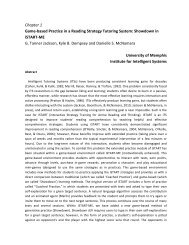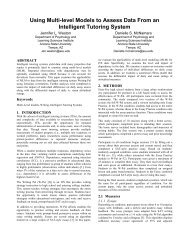Identifying Text Genres Using Phrasal Verbs
Identifying Text Genres Using Phrasal Verbs
Identifying Text Genres Using Phrasal Verbs
Create successful ePaper yourself
Turn your PDF publications into a flip-book with our unique Google optimized e-Paper software.
Predictions<br />
Biber (1988) created an empirical separation of spoken<br />
versus written text by using a corpus of spoken text, the<br />
London-Lund corpus (LLC), and a corpus of written text,<br />
Lancaster-Oslo-Bergen (LOB). Biber’s factor analysis<br />
focuses on 67 lexical features but was unable to<br />
computationally separate the two modes. However,<br />
because phrasal verbs are believed to be more common in<br />
spoken and informal registers (CITE), we predicted that<br />
phrasal verbs frequency would be a sufficient marker to<br />
computationally discriminate between spoken and written<br />
texts. Specifically, we predicted that phrasal verbs would<br />
appear more often in spoken text than in written text.<br />
Biber (1988) identified his fifth dimension, based on<br />
degree of abstractness, as a formal/informal distinction.<br />
Biber ranked the registers within this dimension from<br />
most informal (non-abstract) to most formal (abstract).<br />
Since previous studies have suggested that phrasal verbs<br />
are more likely to be informal than formal (Biber, 1987;<br />
McWhorter, 2001), we predicted a higher frequency of<br />
phrasal verbs at the informal end of Biber’s fifth<br />
dimension.<br />
An equally interesting dichotomy reported by Louwerse<br />
et al. (2004) was their first dimension distinction between<br />
spoken and written texts. Louwerse and colleagues<br />
developed this dimension into a ranking of text registers<br />
from most spoken to most written. Since phrasal verbs are<br />
more likely contained in spoken text than in written text<br />
(Biber, 1987; McWhorter, 2001), we also predicted a<br />
higher frequency of phrasal verbs at the spoken end of the<br />
Louwerse and colleagues’ first dimension. Our<br />
predictions, therefore, were that phrasal verb frequencies<br />
would correlate significantly with Biber’s fifth dimension<br />
and Louwerse et al.’s first dimension, as these are the<br />
dimensions that most closely reflect the function of<br />
phrasal verbs. Such findings would supply evidence that<br />
phrasal verbs frequency is indicative of established text<br />
dimensions.<br />
In addition, as the Biber fifth dimension has its registers<br />
ranked in terms of degree of informality, and as the<br />
Louwerse and colleagues first dimension ranks their<br />
registers in terms of degree of spokenness, we further<br />
predicted that correlations between these individual<br />
rankings and those produced by frequencies of phrasal<br />
verbs would be significant. As such, we predicted that not<br />
only would phrasal verbs distinguish text genres along the<br />
lines of formality and spokenness, but that they would<br />
also distinguish text genres in terms of degree of<br />
formality and spokenness.<br />
Experiment 1<br />
To examine whether phrasal verbs predicted<br />
spoken/written variation and formal/informal variation,<br />
we first analyzed the same corpora as those used in the<br />
Biber (1988) and Louwerse et al. (2004) studies (see<br />
Table 1). Note, however, that as Biber’s study used an<br />
unobtainable private collection of personal and<br />
professional letters, we used the letters from the Louwerse<br />
and colleagues’ study.<br />
Table 1: Registers used in Biber (1988) and Louwerse et<br />
al. (2004).<br />
Corpus<br />
Lancaster-<br />
Olso-Bergen<br />
corpus<br />
London-<br />
Lund corpus<br />
Additional<br />
Register<br />
Press reportage, editorials, press reviews,<br />
religion, skills and hobbies, popular lore,<br />
biographies, official documents, academic<br />
prose, general fiction, mystery fiction,<br />
science fiction, adventure fiction,<br />
romantic fiction, humor<br />
Face-to-face conversation, telephone<br />
conversation, public conversations,<br />
debates, interviews, broadcast,<br />
spontaneous speeches, planned speeches<br />
Personal letters, professional letters<br />
Because the spoken corpus and written corpus differed<br />
in terms of length, only the first 1000 words from each<br />
text were considered to control for a text length confound.<br />
For a corpus of phrasal verbs, we used the 397 most<br />
commonly occurring phrasal verbs, supplied in Hart<br />
(1999). To account for grammatical variation, the phrasal<br />
verbs were transformed into five forms: base form (e.g.,<br />
go around), 3 rd person (e.g., goes around), progressive<br />
form (e.g., going around), 2 nd form (e.g., went around),<br />
and 3 rd form (e.g., gone around). Only unique<br />
transformations were considered.<br />
The frequencies of phrasal verbs were calculated using<br />
a Visual Basic program specifically written for this study.<br />
The counts were separated by verb form and text. Counts<br />
were also normalized before being output for data<br />
analysis purposes.<br />
Results<br />
An ANOVA was performed on the frequency of<br />
occurrence of phrasal verbs in the empirical separation of<br />
spoken versus written text: LOB (written)/LLC (spoken).<br />
The means are shown in Table 2. The frequencies in this<br />
analysis and in the remaining analyses tended not to be<br />
normally distributed. Therefore, we conducted the Mann-<br />
Whitney non-parametric test (i.e., U in Tables) as well as<br />
an ANOVA (F in Tables). With the exception of the<br />
frequency of 2 nd forms, all categories of phrasal forms<br />
significantly distinguished spoken from written registers.<br />
Our second question regarded the relevance of phrasal<br />
verbs to the formal versus informal distinction made by<br />
Biber (1988). Both a Mann-Whitney non-parametric test<br />
and an ANOVA were performed on the frequency of<br />
occurrence of phrasal verbs in informal versus formal


